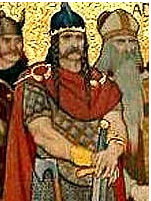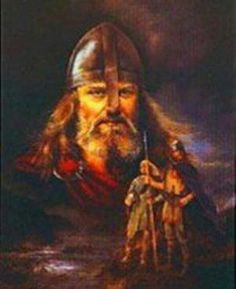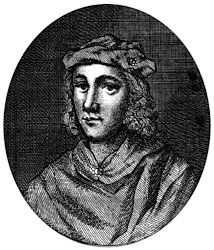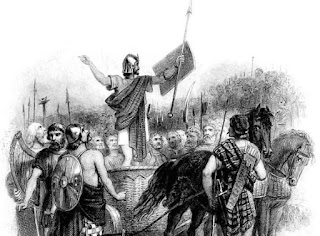Kenneth MacAlpin
King of Scotland
Kenneth MacAlpin came out of relative obscurity to found a royal line that ended with Bonnie Prince Charlie almost a thousand years later.
Famed for uniting the Picts and the Gaels, many legends have grown up about him. These produced a contradictory series of tales – few of which can be taken at face value.
Kenneth – or in Gaelic, Cináed mac Ailpín was born about 800AD, in Dál Riata - which, despite the prestige of lona, had become a backwater. Most of the kings who ruled in this period paid tribute to the Picts, who were the regional superpower.
The first Viking raids upon Britain and Ireland were taking place at this time. Lindisfarne was burned in 793 and Iona was attacked half a dozen times before 826.
The Pictish heartland escaped serious attack from these early raiders, but the smaller and less well organised kingdom of the Gaels of Dál Riata where Kenneth was growing up – was thrown into disarray. The one spirited king, Aed the White, had died in 778 and none of the rulers who followed him had been able to fill his shoes or stand up to the Vikings or the Picts.
Indeed, during Kenneth's boyhood and youth the king of Dál Riata - Domnall
(811-835) - was a son of the king of the Picts.
With the Picts controlling the rich lands east of the mountains and the Vikings roving the western seas, the Gaels were caught in a perilous situation.
When Unust, king of the Picts, died in 834 he was succeeded by his nephew
Drest (834-837), but Drest's accession was challenged by another prince called Talorgan.
Drest was supported by his brother Domnall who sent men to his aid from Dál Riata. In the fighting a Gaelic prince, Alpín son of Eochaid, a grandson of Aed the White, was captured and beheaded.
This man was the father of Kenneth MacAlpin. In this struggle Drest prevailed, and when he died he was succeeded by his cousin Uuen son of Unust.
Meanwhile the kingship of Dál Riata passed to Aed son of Boanta who remained on good terms with the Picts.
In 839 disaster struck. The Vikings, who had so far left Pictland relatively unscathed, appeared in force and in one huge battle slew King Uuen, his brother Bran and Aed, King of Dál Riata, who had come to help his Pictish friends.
The royal family was wiped out. Uuen and Bran were too young to have grown sons, and the succession fell into chaos, no doubt increased by fear of the Vikings. For a while things were held together by a king named Wrad (839-842), who had his royal residence at Meigle near Coupar Angus, but when he died civil war broke out.
Fighting raged in the Pictish kingdom for seven years. Amongst the contenders was Alpin's son Kenneth, who had succeeded to the kingship of Dál Riata following the slaying of Aed.
Neither Kenneth's father, nor his father's father, had been king, but it is quite likely that he was related to the Pictish royal line - the House of Constantín - through his mother or grandmother.
As a man of mixed blood he was in an ideal position to bring the two kingdom's together to face the threat of the Vikings.
In the war that followed, Kenneth's main opponents were the sons of King Wrad. The stories vary, but he seems to have invited the last of these, another Drest, to a meeting at Scone, under a flag of truce, and to have treacherously slain him there.
Some later tales portray Kenneth as a conqueror of the Picts, but it seems likely that, although brought up in the Gaelic kingdom of Dál Riata, he was at least as closely related to the royal family of Pictland as the sons of Wrad.
On the Pictish side, people were probably truly divided in their loyalties – as many supporting Kenneth as supported his rivals. On the Gaelic side, of course, the thought that one of their own might win the kingship of the fertile eastern glens and straths filled hearts with the hope of better days to come.
Of course, massacres by the Vikings and years of civil war had led to the death and exile of the Pictish nobility, and Kenneth was in a position to richly reward his followers. But no one could have foreseen what followed.
Kenneth's final victory in Pictland coincided with the arrival on the west coast of the largest Viking fleet yet seen in these islands.
In 849, about 140 longships cruised down the coast on their way to Ireland, 'causing great confusion in the whole country'. This proved the last straw for the Gaels of Dál Riata. For more than a generation, the islands and promontories of Argyll had suffered from the depredations of these sea-borne marauders, and the people had been pushed to the limit.
The monasteries had been particularly hard hit. It was the saints of Dál Riata, whose bones and memories were revered in these monasteries, who gave the Gaels what was left of their self-respect. In recent generations their kings may not have been as glorious as they had once been, but the people could console themselves in the knowledge that it was their saints who had carried Christianity to the Picts and the Northumbrians and that those peoples still honoured them for this.
In 849 the kindreds of Dál Riata opened up the tombs of their saints and placed the bones in the shrines that had been made to carry the relics about the churches on the great festivals of the year.
As the children of Israel had carried the Ark of the Covenant before them when they left the wilderness and crossed over the Jordan into Canaan, so the kindreds of the Gael carried the relics of their saints before them as they crossed the Highlands into Pictland.
From Kingarth on Bute the kindred of Comgall took the relics of Saint Blane northwards through Cowal and up into Glen Dochart. Then they went down through Strathyre and Menteith, until they came to Strathallan, where they built a new church for the relics, naming it ' The fortress of Blane ' - Dunblane
The kindred of Loairn carried the relicts of their Saint, Moluoc, from Lismore to Rosemarkie on the Moray Firth singing the sad songs time with their oars as they rowed of exile in northwards over the still waters of Loch Lochy and Loch Ness,
And from lona, the greatest of all the churches of Dál Riata, the kindred of Gabrán - Kenneth's own people took up the bones of the great Saint Columba, and carried them into the country, past the head of Loch Awe and through Strathfillan till they came to Loch Tay, and then down the Tay until they reached Dunkeld.
A great new church had been built at Dunkeld, in Columba's honour, by King Constantin of the Picts more than 30 years before. It was here that Kenneth placed the relics of the Saint, marking as he did so the fusion of east and west that existed in his kingdom. Dál Riata disappears from history at this point, doubtless, some of the Gaels stayed on, but most of the land passed into the lordship of Viking chiefs whose names are lost.
In the chronicles of the time the Gaels of Britain also disappear and for 50 years we hear only of the Picts ruled by Kenneth and his successors.
But how did Kenneth accommodate these refugees and immigrants without driving his Pictish subjects into rebellion? The Gaels were far fewer in number than the Picts and many of them were doubtless settled on land confiscated from the followers of the sons of Wrad after the civil war.
To avoid tensions between natives and incomers, Kenneth also adopted another policy used by throughout the ages who face unrest and trouble at home – He began a foreign war.
Six times between 849 and his death in 858 Kenneth invaded the kingdom of Northumbria.
The high points of these wars were the burning of Dunbar, a royal fortress of the Northumbrians, and the destruction of Melrose, one of their greatest monasteries, for in those days the Forth marked the border between Pictland and Northumbria.
For the most part, Kenneth's expeditions were probably confined to the burning of farms and the taking of cattle and young women to be distributed amongst his followers, Gael and Pict alike.
The policy worked, and in their shared hatred of a common enemy the Picts and the Gaels forgot their differences.
When Kenneth died at his palace in Forteviot in 858, he was commemorated as King of the Picts. At his court, the great men of Church and war probably switched easily between Gaelic and Pictish speech, and his chief lieutenants would have been drawn from both peoples.
The Picts were probably glad that they now possessed the bones of their evangelists and probably expected that the Gaels would eventually adopt their language and culture.
None, however, could see what lay before them. Kenneth's sons were young, born after his accession to the Pictish throne, probably to a Pictish mother, and so the kingdom passed to his brother Dominall (858-862).
In death the Gaelic poets remembered Kenneth MacAlpin thus:
That Kenneth with his host is no more
brings weeping to every home.
No king of his worth under heaven
is there, to the bounds of Rome.












Comments
Post a Comment